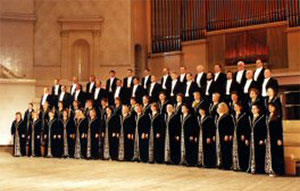by Mike Telin

On Wednesday, December 4 beginning at 9:00 pm in the Cleveland Museum of Art’s Ames Family Atrium, Valery Polyansky will lead the State Symphony Capella of Russia in a concert featuring Russian liturgical music, choruses and folk songs. David J. Rothenberg, associate professor of music at Case Western Reserve University, will discuss Marian music and ties to the museum’s collection at 7:30 p.m. in Gartner Auditorium. The concert is part of CMA’s Performing Arts “Mother and Child” Series.
Due to language barriers, Maestro Polyansky graciously agreed to answer questions through a translator via e-mail.
Mike Telin: Tell us about your program: why did you choose the repertoire?
Valery Polyansky: Our tour is taking place during a very exciting time – Thanksgiving in your country, Khanukha that is celebrated around the world, and, of course, Christmas. Every family around the world has something to celebrate during this time. We tried to put a program together that will suit everyone’s state of mind, despite the religious holidays of different nations.
Having said that, I wanted to unite this program with some kind of a theme. The “Russian Christmas” came to my mind. We will start our program with some Russian Orthodox Classics that were performed in the old Russia many centuries ago. Another segment of the holiday program was based on some Western Holiday classics. Of course, we could not forget about the Russian Folk Songs, which are part of everyone’s repertoire during the holidays in Russia. I thought that it would be very traditional and special for us to sing some Christmas Carols, which are known around the world. I am sure that the American audience is very familiar with the Carols that we would feature in our program.
We just wanted to offer our version of the Christmas selections. We have heard there are more hymns to Mary in the Eastern Orthodox Liturgy then in the Roman Catholic Liturgy.
MT: When in history did the theotokia begin?

The reason for this is that the term “Theotokos” is understood by Orthodox Christians to have not only pious but also theological significance: in calling the Virgin Mary the “Birthgiver of God.” it is affirmed that Christ possesses a human nature as well as a divine nature (as opposed to being purely divine). This is an essential understanding in the Orthodox doctrine of theosis. Therefore, the title “Theotokos” is as much a statement about Christ as it is about the Virgin Mary herself. I always prefer to answer musical questions, rather than historical ones. I leave this job to other people who specialize in that sort of things.
MT: You have performed in Cleveland at least twice in the past three years, what do you like about the city?
VP: We appreciate the fact that you have a very knowledgeable audience. I remember the first performance in Cleveland. We spent a lot of time going back and forth working out the repertoire that will be unique to our performance, as well as interesting for your audience. People that run your concert series know exactly what they want to hear, and by whom. I have a lot of respect for that!
Published on ClevelandClassical.com November 29, 2013
Click here for a printable version of this article.

